You are using an out of date browser. It may not display this or other websites correctly.
You should upgrade or use an alternative browser.
You should upgrade or use an alternative browser.
Can someone explain why x amount of screws makes a gun more valuable?
- Thread starter Viper99
- Start date
lee n. field
New member
dates it to a particular era.
^^^ Yes, On what lee n. field stated^^^ At least for S&W from 1905 to 1955 most hand ejector revolvers had 5 screws on the side plate. Four screws were prevalent from 1955 to about 1961 and afterwards it was down to three screws.
Then from about 1896 to 1905 it was four screws.
On some models one plate screw can be covered by the grip.
The above information was extracted from the publication "Standard Catalog of Smith & Wesson".
Then from about 1896 to 1905 it was four screws.
On some models one plate screw can be covered by the grip.
The above information was extracted from the publication "Standard Catalog of Smith & Wesson".
As noted, describing a S&W or a Ruger Blackhawk (2 examples off the top of my head) by the number of screws is a quick way to describe the age of the gun.
As a general rule older is more valuable. Saying "4 screw M19" means it was made in the late 1950s when the bluing was fabulous and the quality of workmanship was top notch. The number of screws isn't what makes the gun desirable, it's the period of manufacture identified by the screw count.
Although in the case of the Ruger, a 3 screw would be a completely different design than the 2 screw "New Model" with the older one being more desired.
As a general rule older is more valuable. Saying "4 screw M19" means it was made in the late 1950s when the bluing was fabulous and the quality of workmanship was top notch. The number of screws isn't what makes the gun desirable, it's the period of manufacture identified by the screw count.
Although in the case of the Ruger, a 3 screw would be a completely different design than the 2 screw "New Model" with the older one being more desired.
The others covered it. I just like them because they're older. When you're talking Smith & Wesson, the four screw models are probably more desirable to some people simply because they didn't make as many of them so they don't turn up as often.
Not long ago, I found a four screw Model 19. I jumped on it because it was a four screw.
Not long ago, I found a four screw Model 19. I jumped on it because it was a four screw.
I do believe that it is 4 screws on the side plate, or 3 screws, and the 5th screw or 4th screw is in the front of the trigger guard.At least for S&W from 1905 to 1955 most hand ejector revolvers had 5 screws on the side plate. Four screws were prevalent from 1955 to about 1961 and afterwards it was down to three screws.
My model K-17 has 3 screws on the side plate and 1 screw in the front of the trigger guard, hence 4 screw model . It left S&W on Sept. 12, 1960
In the case of the Ruger single actions, a "three screw" action didn't have a safety so it worked more like a real Colt - including a really nice trigger feel. The 1973-and-forward "two screw" (aka "New Model") action has a safety in it - won't go "boom" if you drop it fully loaded ("transfer bar ignition").
Complicating matters: Ruger did a "free safety upgrade" for the three-screws that was a train wreck (Rube Goldberg design, plus horrid trigger feel) so everybody looks for no-safety variants of the three-screws, plus a lot of people assumed for a long time that the two-screw safety must be junk as well when it's really not and it's even possible to get a decent trigger out of it.
My one Ruger SA (also my daily carry) is a New Model action with the safety intact - more or less the only thing I haven't tampered with on that critter, come to think .
.
Complicating matters: Ruger did a "free safety upgrade" for the three-screws that was a train wreck (Rube Goldberg design, plus horrid trigger feel) so everybody looks for no-safety variants of the three-screws, plus a lot of people assumed for a long time that the two-screw safety must be junk as well when it's really not and it's even possible to get a decent trigger out of it.
My one Ruger SA (also my daily carry) is a New Model action with the safety intact - more or less the only thing I haven't tampered with on that critter, come to think
Bob Wright
New member
Minor point here regarding New Model Ruger Single Actions, they are not truly "two screw" but rather two pins. The two pin design eliminated the tendency for the frame screws to work loose in firing.
(Still has those screws in the ejector housing and grip frame.)
Bob Wright
(Still has those screws in the ejector housing and grip frame.)
Bob Wright
Driftwood Johnson
New member
Howdy
To further expand on what SaxonPig said, although the number of screws on a S&W can be used as a rough guide for when it was manufactured, and may or may not be an indicator of the craftsmanship involved in making it, the reason S&W changed the number of screws was pure economics.
Ever since the first guy made the first wheel, manufacturers have always striven to drive the cost out of making their products. This is only natural. If a manufacturer can save 10 cents by a design change that eliminates parts or reduces labor, they will do it every time.
The very first 38 caliber side swing revolvers made by S&W in 1899 had four screws holding down the side plate and no screw in front of the trigger guard. But in 1905 the internal mechanism went through major changes, and the Five Screw Smith was born. Here is a photo of one, made about 1908. You can plainly see the four screws holding the side plate on.
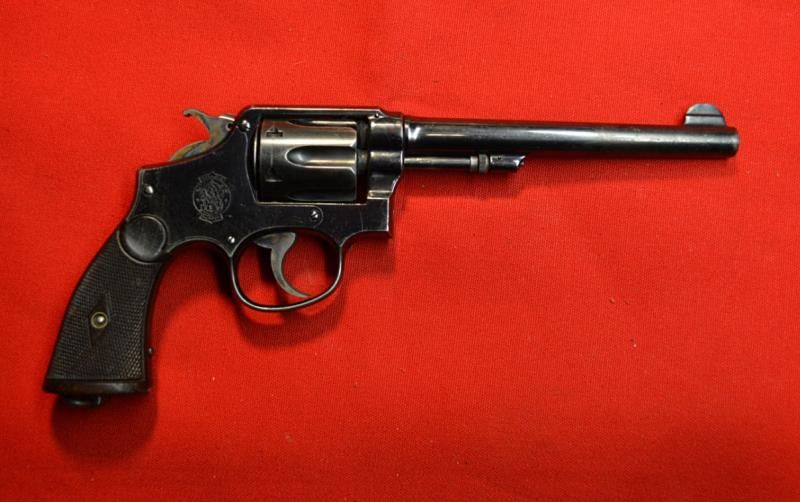
And here is the Fifth screw, in front of the trigger guard.
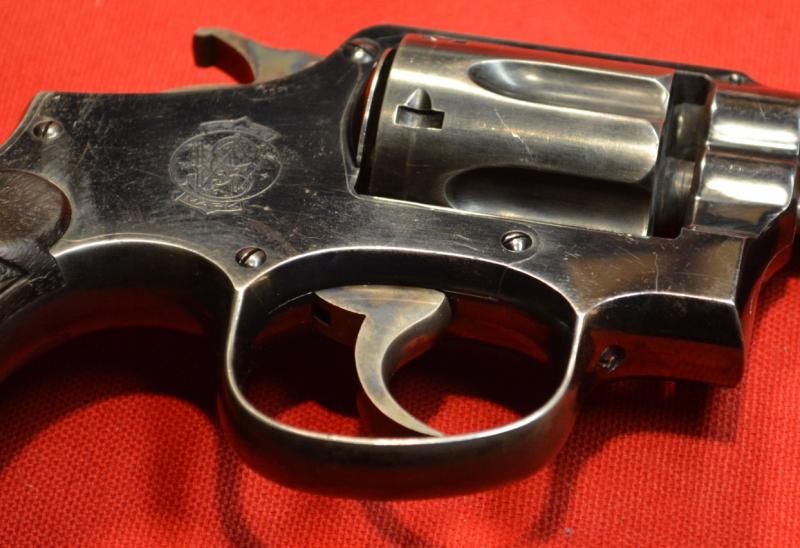
Believe it or not, it is more expensive to drill and tap holes than it is to do a little bit of extra machining. So in 1955 S&W eliminated the screw at the top of the side plate, near the hammer. They did this by machining a small tab onto the top of the side plate. The tab fits into an undercut slot milled into the frame. This eliminated drilling and tapping one hole, and it eliminated one screw from the parts list. Plus it eliminated a few seconds of assembly time for the missing screw. Time is money after all. This is how the Four Screw Smiths came about.
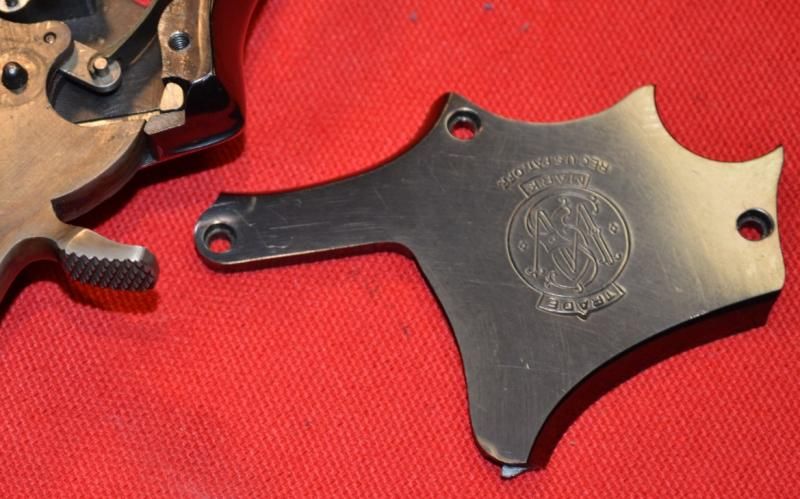
This is the only Four Screw Smith in my collection, a Model 27. Notice it still has the screw in front of the trigger guard. The fourth screw is hidden under the top of the grips.
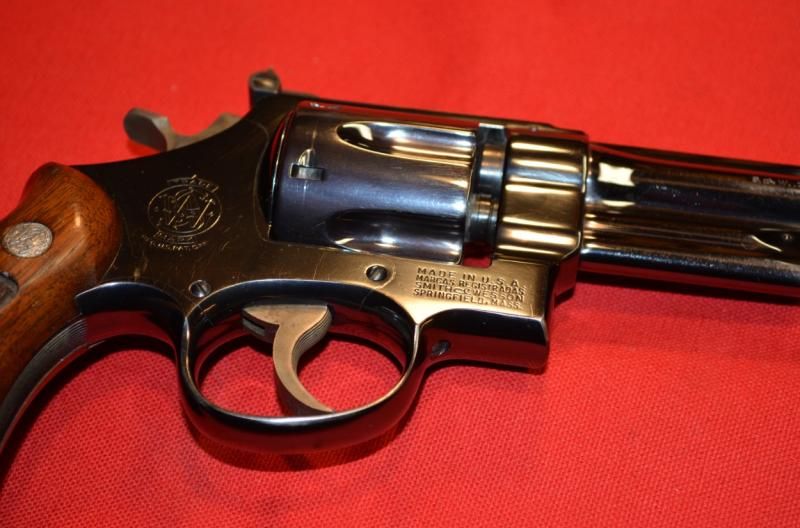
This photo shows another old Smith disassembled. This solves the mystery of what is under the screw in front of the trigger guard. The parts in front of the trigger guard are the cylinder stop, the spring and plunger that operate it, and the screw that keeps them in position. The spring and plunger fit into the hole in front of the trigger guard. The screw keeps them in position. The pressure provided by the spring is what causes the cylinder stop to pop up and lock the cylinder in place.
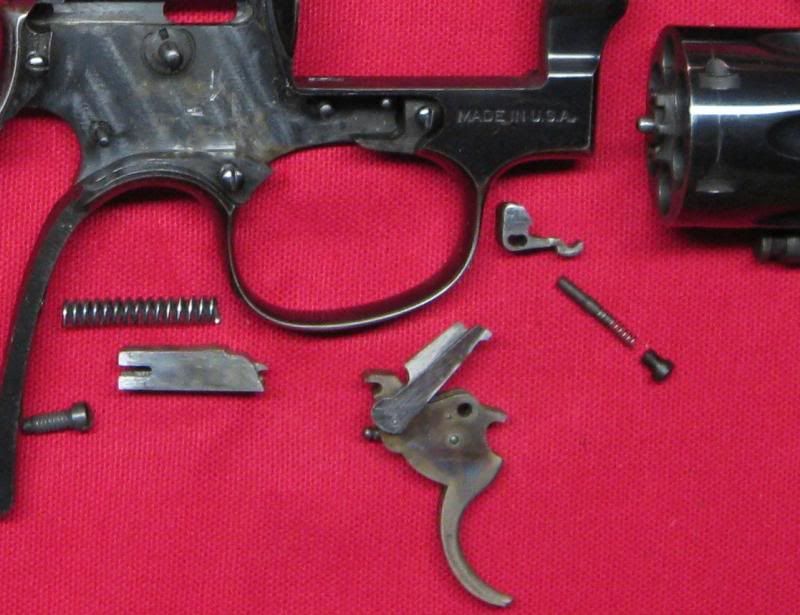
In 1962 S&W eliminated the screw in front of the trigger guard, creating the Three Screw Smiths that are still made today. Instead of the old screw and plunger in their own hole, the design now consists of just a spring, jammed into a recess in the frame and bearing directly against the cylinder stop. You can see the spring in this photo, scrunched up between the frame and the cylinder stop. S&W saved money by eliminating the extra screw and plunger, and they saved more money by not drilling and tapping the hole. For what it's worth, I hate this design change. If the spring needs servicing or replacing, the entire gun needs to be disassembled to access the spring. And it is tricky getting it back in position without it sproinging across the room. But S&W saved a few cents with this design change and we have been stuck with it ever since. So much simpler to change bolt springs with a Four Screw or Five Screw.
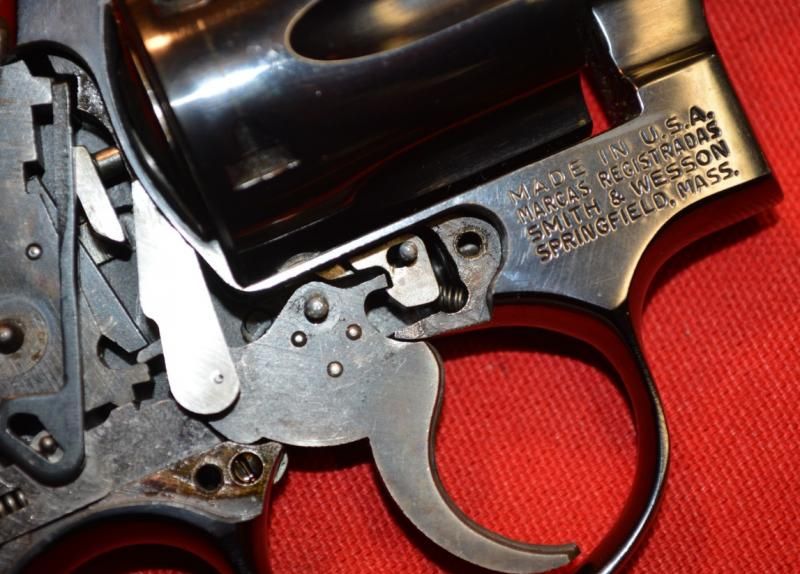
To further expand on what SaxonPig said, although the number of screws on a S&W can be used as a rough guide for when it was manufactured, and may or may not be an indicator of the craftsmanship involved in making it, the reason S&W changed the number of screws was pure economics.
Ever since the first guy made the first wheel, manufacturers have always striven to drive the cost out of making their products. This is only natural. If a manufacturer can save 10 cents by a design change that eliminates parts or reduces labor, they will do it every time.
The very first 38 caliber side swing revolvers made by S&W in 1899 had four screws holding down the side plate and no screw in front of the trigger guard. But in 1905 the internal mechanism went through major changes, and the Five Screw Smith was born. Here is a photo of one, made about 1908. You can plainly see the four screws holding the side plate on.

And here is the Fifth screw, in front of the trigger guard.

Believe it or not, it is more expensive to drill and tap holes than it is to do a little bit of extra machining. So in 1955 S&W eliminated the screw at the top of the side plate, near the hammer. They did this by machining a small tab onto the top of the side plate. The tab fits into an undercut slot milled into the frame. This eliminated drilling and tapping one hole, and it eliminated one screw from the parts list. Plus it eliminated a few seconds of assembly time for the missing screw. Time is money after all. This is how the Four Screw Smiths came about.

This is the only Four Screw Smith in my collection, a Model 27. Notice it still has the screw in front of the trigger guard. The fourth screw is hidden under the top of the grips.

This photo shows another old Smith disassembled. This solves the mystery of what is under the screw in front of the trigger guard. The parts in front of the trigger guard are the cylinder stop, the spring and plunger that operate it, and the screw that keeps them in position. The spring and plunger fit into the hole in front of the trigger guard. The screw keeps them in position. The pressure provided by the spring is what causes the cylinder stop to pop up and lock the cylinder in place.

In 1962 S&W eliminated the screw in front of the trigger guard, creating the Three Screw Smiths that are still made today. Instead of the old screw and plunger in their own hole, the design now consists of just a spring, jammed into a recess in the frame and bearing directly against the cylinder stop. You can see the spring in this photo, scrunched up between the frame and the cylinder stop. S&W saved money by eliminating the extra screw and plunger, and they saved more money by not drilling and tapping the hole. For what it's worth, I hate this design change. If the spring needs servicing or replacing, the entire gun needs to be disassembled to access the spring. And it is tricky getting it back in position without it sproinging across the room. But S&W saved a few cents with this design change and we have been stuck with it ever since. So much simpler to change bolt springs with a Four Screw or Five Screw.

Last edited:
I'll second the motion on Driftwood Johnson's excellent post with pictures. I learned those things over the last couple decades since I've been chasing S&W revolvers, but I've never seen such a succinct explanation with fine pictures. Everything that answers the question without anything else in the way. Very well done.
To the subject, I would replace the term "valuable" with the term "different." It simply isn't going to be the case where they are more valuable. While the number of screws is directly associated with the age, and "value" is quite often associated with age, there are so many more factors that weigh heavily in to value. Rarity & condition are the big ones.
To put that thought another way, I would chase a 3 or 4-screw Smith & Wesson over a 5-screw if the 3-screw in question were in better shape. But the value thing is a big, crazy game. I seem to get FAR more enjoyment from the guns with less "value" because shooting them doesn't risk affecting that value. But that's just one guy's opinion.
But that's just one guy's opinion.
To the subject, I would replace the term "valuable" with the term "different." It simply isn't going to be the case where they are more valuable. While the number of screws is directly associated with the age, and "value" is quite often associated with age, there are so many more factors that weigh heavily in to value. Rarity & condition are the big ones.
To put that thought another way, I would chase a 3 or 4-screw Smith & Wesson over a 5-screw if the 3-screw in question were in better shape. But the value thing is a big, crazy game. I seem to get FAR more enjoyment from the guns with less "value" because shooting them doesn't risk affecting that value.
Bill DeShivs
New member
I'm just going to buy a bunch of gun screws. I'll be rich!
Driftwood Johnson
New member
Howdy Again and thanks for the kind remarks
Re: Three Screw Rugers.
I dunno why, but when Bill Ruger designed the old Three Screws he put the screw heads on the right side of the frame.

Just the opposite of Colts.
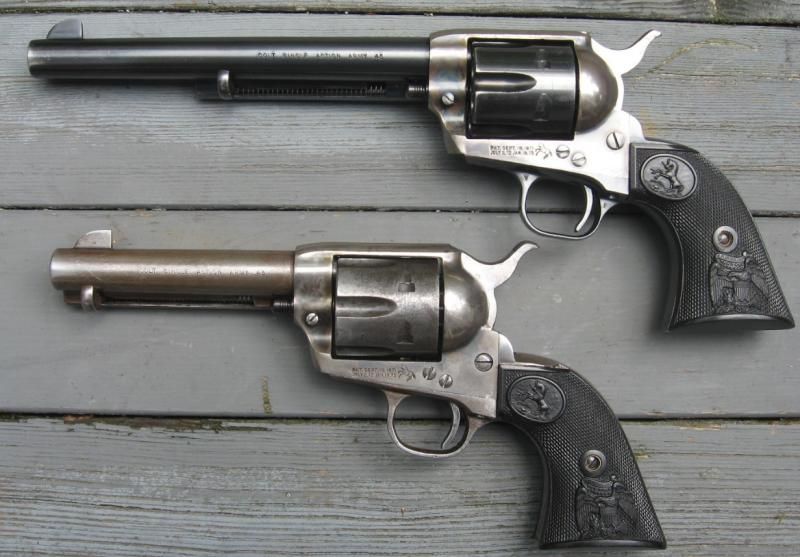
I have always found that interesting.
Re: Three Screw Rugers.
I dunno why, but when Bill Ruger designed the old Three Screws he put the screw heads on the right side of the frame.

Just the opposite of Colts.

I have always found that interesting.
Bob Wright
New member
What is really a great find is to get ahold of a Colt with no screws visible.
(Yes, they were made.)
Bob Wright
(Yes, they were made.)
Bob Wright
Bob Wright
New member
Bill DeShivs said: I'm just going to buy a bunch of gun screws. I'll be rich!
A no-gun screw? Bill, it's been done.
Bob Wright
Lost Sheep
New member
Not just screws
Other characteristics used in the "shorthand" of gun descriptions are used to differentiate (especially among collectors) help identify when guns were made, but have little to do with the actual functionality of the gun.
"Pinned barrel", "recessed chambers" and "no dash" come to mind. (S&W used to put a pin in the frame where the barrel screws into the frame, but discontinued the practice at some point, recessing the back of the cylinder to enclose the rims of the cartridges completely and having a hyphen/dash in the serial number followed by a model designation) The pinned barrel may have some real value, the recessed chambers used to have some value when folded or "balloon head" cases were still used and the presence or absence of a dash in engraved on the frame has no function at all. But all do help identify dates of production and are a useful shorthand for the cognoscenti.
Kind of like "pre-1964 Winchester 94" indicates those lever-action Winchester Model 94 Carbines with forged actions vs post-1964 with some stamped parts, less fine of a finish and plastic buttplate.
Useful shorthand words and phrases that in some cases have become "terms of art" or sometimes just jargon.
Lost Sheep
Other characteristics used in the "shorthand" of gun descriptions are used to differentiate (especially among collectors) help identify when guns were made, but have little to do with the actual functionality of the gun.
"Pinned barrel", "recessed chambers" and "no dash" come to mind. (S&W used to put a pin in the frame where the barrel screws into the frame, but discontinued the practice at some point, recessing the back of the cylinder to enclose the rims of the cartridges completely and having a hyphen/dash in the serial number followed by a model designation) The pinned barrel may have some real value, the recessed chambers used to have some value when folded or "balloon head" cases were still used and the presence or absence of a dash in engraved on the frame has no function at all. But all do help identify dates of production and are a useful shorthand for the cognoscenti.
Kind of like "pre-1964 Winchester 94" indicates those lever-action Winchester Model 94 Carbines with forged actions vs post-1964 with some stamped parts, less fine of a finish and plastic buttplate.
Useful shorthand words and phrases that in some cases have become "terms of art" or sometimes just jargon.
Lost Sheep
Lost Sheep
New member
Not screws. Bolts
What makes these designations "three-screw Smiths", "Flat-top Rugers" etc so popular is the bolts associated with them.
You see. In order for a bolt to work, it must be mated with a nut.
In this case, Gun Nuts.
Lost Sheep, Suffering insomnia. Have pity.
What makes these designations "three-screw Smiths", "Flat-top Rugers" etc so popular is the bolts associated with them.
You see. In order for a bolt to work, it must be mated with a nut.
In this case, Gun Nuts.
Lost Sheep, Suffering insomnia. Have pity.
